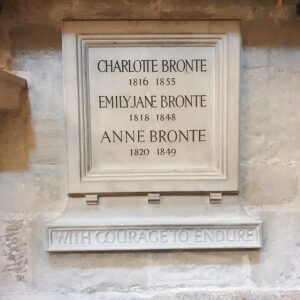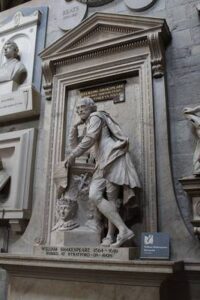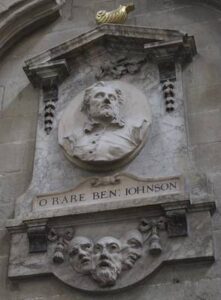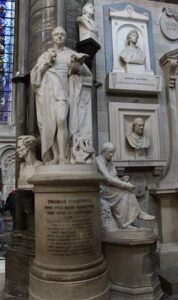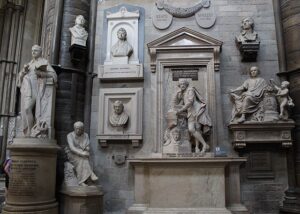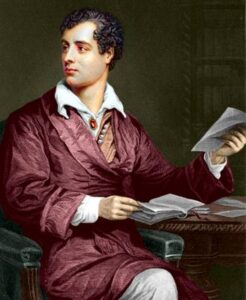Exploring Poets’ Corner: A Journey Through Westminster Abbey’s Literary Legacy
Date post added: 7th August 2024
Arguably, Westminster Abbey is the world’s most impressive and historic Christian church. It was built under Edward the Confessor’s instruction. It’s been the site of royal coronations (including King William I, Queen Elizabeth I and Queen Victoria), royal weddings (Queen Elizabeth II and Philip Mountbatten, Prince William and Kate Middleton) and it’s the final resting place of many royals (such as Henry VII, Mary Queen of Scots and James I).
But Westminster Abbey’s role in British history is not simply aligned with royalty. More than 100 poets, playwrights and writers are buried or have memorials here too. In the south transept of the Westminster Abbey, you’ll find Poet’s Corner – a place to commemorate and remember literary greats. If you’re wondering who’s buried there and why, read on.
What is the history of Poets’ Corner?
In 1400, one of England’s most famous writers, Geoffrey Chaucer – author of The Canterbury Tales – was the first poet to be buried in Westminster Abbey. It wasn’t because of his literary prowess though. It was due to his position as Clerk of the King’s Works. Over a century later, in 1556, Nicholas Brigham created a grey Purbeck marble monument for Geoffrey Chaucer. According to William Camden in his 1600 guide to Westminster Abbey, Chaucer’s bones were placed inside. Chaucer’s family, however, are all buried near Oxford.
Next came Edmund Spenser who wrote one of the longest poems in the English language, The Faerie Queene for Queen Elizabeth I. Spenser clearly liked the look of Chaucer’s striking monument, so asked to be buried near him. When he died in 1598, his wish was granted and so began a tradition of burials and memorials which continues to this day.
The job of deciding which poets and literary greats get a spot in Poets’ Corner is down to the Dean of Westminster.
Where is Poets’ Corner?
The Poets’ Corner can be found in the south transept of Westminster Abbey in London. The corner itself is in the eastern aisle. As the number of people buried here has expanded, so has the ‘corner’ itself. It now extends across the entire transept.
Look around this area and hear its rich history on our Westminster Abbey walking tour
The different types of Poets’ Corner memorial
There’s a range of memorial types in this section of Westminster Abbey. You’ll find inscribed stone slabs on the floor – like historic stars on the Hollywood Walk of Fame. Others, have elaborate stone monuments, busts or hanging stone tablets. The English writer, Elizabeth Gaskell has a panel in the memorial window. That was only unveiled in September 2010. As space on the floor of Poets’ Corner runs out, new spots (like this memorial window) need to be found.
The Brontë sisters are remembered together in a joint memorial. Whilst it was commissioned in 1939, the Second World War meant that it wasn’t unveiled until 1947. Sixteen of the First World War poets share a stone floor slab. The four founders of the Royal Ballet are also remembered here.
Who is actually buried in Poets’ Corner, Westminster Abbey?
There’s a long list of renowned British poets (and indeed Poet Laureates) here, and we share a list of some of the best known below. But a number of clergymen, actors and even the musician George Frederic Handel have also been buried here.
Poets don’t tend to get buried here straight away. Many are commemorated long after their death. William Shakespeare, for example, received a memorial monument in 1740. That was well over a century after his death.
Early poets
Ben Jonson, Elizabethan poet and playwright (and one of William Shakespeare’s besties) isn’t in Poets’ Corner, he’s in the north aisle of the nave. And that isn’t the only unusual thing about his burial plot. He’s actually buried standing up! He couldn’t afford a 6’ by 2’ plot, so he paid for a mere square foot. So ‘Oh Rare Ben Jonson’ is in there like a tent peg.
John Dryden
18th century poets
- Robert Burns
- Samuel Johnson
- John Milton
- Alexander Pope
19th century poets
- W.H. Auden
- Jane Austen
- Elizabeth Barrett Browning
- William Blake
- Robert Browning
- Percy Bysshe Shelley
- Lewis Carroll
- Charles Dickens
- George Eliot
- Thomas Hardy
- John Keats
- Edward Lear
- William Makepeace Thackerey
- Samuel Taylor Coleridge
- Alfred, Lord Tennyson
- William Wordsworth
20th century poets
- John Betjemen
- D.H. Lawrence
- C.S. Lewis
- Philip Larkin
- Ted Hughes
- Rudyard Kipling
- Laurence Olivier
- Dylan Thomas
- Oscar Wilde
Some of these poets and writers were seriously wedded to their homeland. Think Thomas Hardy and his beloved Wessex (Dorset) or Dylan Thomas and Wales. So whilst Thomas Hardy was buried in Poets’ Corner, just near the grave of Charles Dickens, his heart is buried at Stinsford in Dorset.
Which poet was refused burial in Westminster Abbey?
Lord Byron died in 1824, but the scandalous poet didn’t make it to Poet’s Corner until 1969. The Dean of Westminster at the time of his death refused to let Byron be commemorated in the abbey. His ‘questionable morality’ made the Deans decide that he wasn’t suitable for burial at Westminster Abbey.
As a poet, Byron was both lauded and condemned. Rumours of debauchery and worse tarnished his reputation and caused him to seek exile in Greece in the early 19th century. The Greeks admired and adored Byron and his death caused national mourning. Yet the Deans back in England refused to accept his body for burial.
Explore historic Westminster with us
Take a tour of Westminster Abbey with us and we’ll show you these memorial sites and more. We can also introduce you to the iconic political centre of the country on our Westminster walking tour and some of the more hidden, historic sights on our Old Westminster walking tour
Discover the most interesting things to do in Westminster
Find out more information on the official Westminster Abbey site – https://www.westminster-abbey.org – and in James Wilkinson’s book on Poets’ Corner.



